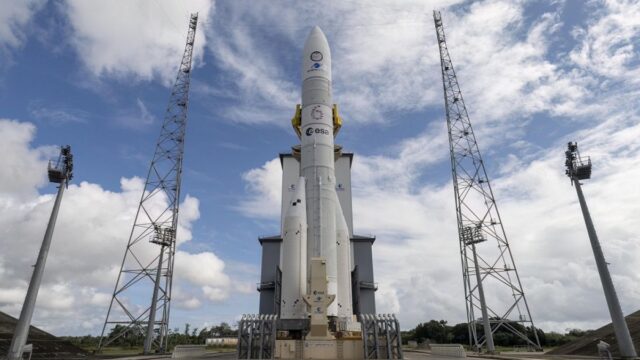The rocket is expected to make its maiden flight this Tuesday, July 9 between 8:00 p.m. and 12:00 a.m.
When this Tuesday thousands of people observe the Ariane 6 rocket launch in French Guiana, in the European Space Agency they will breathe a sigh of relief. Left behind will be what its general director, Josef Aschbacher, defines for ‘Euronews’ as the “pitching crisis”.
In July 2023, with the Ariane’s last journey 5, Europe lost the option of reaching space. And with it the ability to put satellites into orbit without depending on third parties. To the years of delays in the construction of Ariane 6, accompanied by technical problems, the failures of the Vega-C rocket or the pandemic, had been added the end of relations with Russia and the possibility of using Soyuz rockets.
“With the launch of Ariane 6 we are recovering access to space for Europe. This is fundamental,” says Aschbacher from the Kourou Spaceport in Guyana. “At the end of the year we plan a return to flight for Vega-C and we could have other microlaunchers this year.”
If Ariane 6 is a success, “it will increase the resilience of the European space domain in a geopolitical environment of longer-term risks and threats”, the researcher argues from the Elcano Royal Institute, Félix Arteaga. In addition, it will be key to allowing “the European industrial sector to compete with other commercial and government satellites in the short and medium term.”
At a time of space ‘boom’, the premiere of the new European shuttle will allow the continent to put satellites into orbit for the Earth observation, navigation, communication or even for military purposes.
Launches in the hands of Elon Musk
In recent years, Europe has delegated this task to private companies such as SpaceX, Elon Musk’s company, which was in charge of sending several European satellites from the Galileo program into space due to the delays in Ariane 6.
A decision that the European Commissioner for the Internal Market, Thierry Breton, assured that he was making reluctantly. “I’m not happy with what happenedthere were launches that had to be carried out and the schedule was not respected,” he said in November 2023.
“Europe is increasingly aware of the need to be more autonomous in certain strategic areas“explains Matja Rencelj, analyst at the European Space Policy Institute. “We want to launch satellites on our own conditions,” insists the expert.
Although it may not have arrived in time. A few days ago, the European meteorological satellite organization chose Musk’s company to launch one of its satellites. “This decision due to exceptional circumstances. It does not compromise our usual policy of supporting European partners,” said EUMETSAT Director General Phil Evans. it’s a statement. Aschbacher in a tweet He called the decision “surprising,” especially coming just days before the Ariane 6 maiden flight.
Despite this first setback, the future of Ariane 6 already has up to 30 orders. 18 of them to throw lThe Kuipers constellations, Amazon’s project to bring the internet to remote spaces.
According to Rencelj, the launch of Ariane 6 is a first step in the European strategy for space. “The pitcher, after all, is a means to an end and, which in reality is to increase our ambition in the use of space and its utilization, obviously for the benefit of European citizens and European policy makers.
This is why both ESA and Arianegroup, the project’s developer, have placed high hopes in a project that is also designed to transport private satellites into space. Although in the future, explains Aschbacher, “we would like smaller or even larger companies to develop their own new launcher.”
In this way the ESA could be “the fixed client and I would purchase launch services from these companies. Therefore, I would no longer develop my own launcher after Ariane 6.”
Ariane 6 is the first new European model in 30 years. Thirteen European countries have participated in its development and it has cost 4,000 million euros






